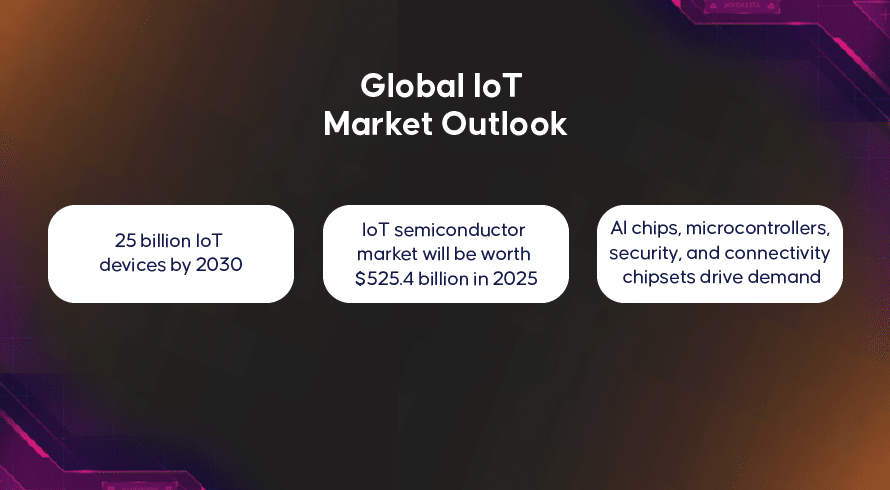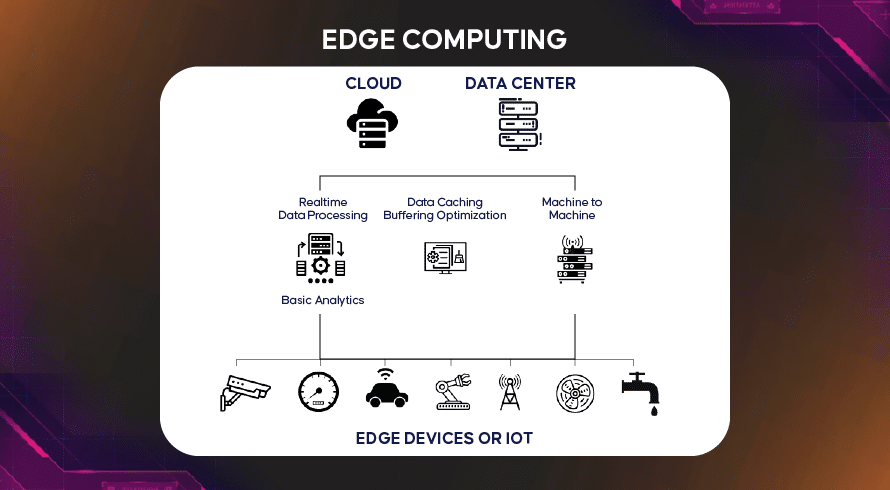
Internet of Things (IoT) applications are quickly becoming popular with consumer and industrial demand both skyrocketing in recent years. From the average IoT device like a smart speaker to advanced sensors now being utilized by the medical, automotive, and aerospace, all of this is possible through the semiconductor components that make those products run. Naturally, the growth in IoT products has had a major impact on the semiconductor industry.
Let’s find out about how IoT products and applications are changing the semiconductor industry, and how semiconductor manufacturers are shifting their focus towards these changes.
Global IoT Market Outlook

The rising demand for semiconductor devices comes from various applications such as mobile devices, gaming, big data analytics, semi-autonomous vehicles, and smart devices connected by the Internet of Things (IoT). The global IoT ecosystem is growing with an estimated 10 billion IoT-connected devices in 2021 and is expected to pass 25 billion by the end of 2030 according to forecasts.
The IoT semiconductor market was worth $392.0 billion in 2020 but is expected to be $525.4 billion in 2025. Among the most popular consumer IoT devices are wearable technologies like smartwatches, and wireless accessories. There is also a multitude of IoT devices that can be set up in a modern smart house.
However, connected devices are not just limited to the consumer market, and industries like healthcare, automotive, industrial, and energy sector are also looking to integrate IoT hardware into their systems. With Industry 4.0 methods like smart manufacturing being introduced, these industrial clients are currently planning on using IoT devices to optimize their production lines, improve yield and minimize costs.
Artificial intelligence (AI) chips, microcontroller units (MCUs), as well as security and connectivity chipsets, are the biggest drivers of growth in IoT semiconductors. While the global outlook for the IoT chip market looks very promising, the rapid adoption of connected devices around the world means that semiconductor companies have several new challenges to overcome. Ultra-low power consumption, built-in security, and increasingly smaller form factors are some of the areas they need to focus on.
How IoT Devices Are Shaping The Semiconductor Industry
The high demand for increasingly complex, smaller, and more feature-filled IoT devices is shaping the semiconductor industry. Apart from this exponential growth in connected devices, other factors impact the IoT chip market like the decline of more traditional technologies, the rise of distributed computer processing techniques, the demand for better security standards, and more.
Decline Of Traditional Technology Applications

As new technologies like smart vehicles, smart speakers, and smart TVs become more popular, their more traditional counterparts show evidence of a decline in sales. Smart TVs are now about half the market for televisions, although they had a smaller portion of the market not too long ago. As a result, features like internet connectivity now come standard, and traditional TVs are taking up a smaller portion of the market.
Similarly, the revenue for smart speakers alone is expected to pass $17 billion in 2022, putting the IoT semiconductors that are used to build them in high demand. This means that semiconductors that are not made for IoT devices are not deemed as valuable as they used to be.
The smartphone market has shown a decline as well, with global sales dropping by 12.5% in 2020. The latest releases aren’t offering much improvement over last year’s models, and consumers are increasingly holding onto their phones for longer. Furthermore, other smart devices are becoming more feature-rich on their own, putting less pressure on consumers to purchase the latest phones. As a result, smartphones which were one of the largest drivers in the semiconductor industry are in decline while IoT semiconductors are starting to contribute more.
IoT Devices In Niche Markets

The IoT market has other areas that show promise as well. These niche applications require specialized products and present new opportunities for semiconductor manufacturers that wish to target these segments. For the smaller companies in the semiconductor industry, it may be easier to produce niche IoT semiconductor devices rather than compete in the already crowded consumer IoT chip market.
The medical industry is one such niche where IoT devices come under much scrutiny due to regulations. The warehouse industry is another where IoT devices like RFID tags that can improve inventory count accuracy are needed. These niches require specialized IoT semiconductor products and show growth potential. However, they are not as competitive as other market segments, presenting semiconductor manufacturers with plenty of opportunities to move in.
Edge Computing

Edge computing is a way of moving the processing that is currently performed by centralized servers and data centers towards a distributed network of connected devices that are on the edge of the network or closer to the end user. Even with the latest improvements in network technology, data has to travel to the data center, be processed, and return a result, creating issues with the response time. This can be improved by IoT devices that are capable of edge computing.
Smart vehicles require IoT semiconductor devices to handle their advanced driver assistance systems at present. However, to truly reach their potential and go driverless, they will need IoT integrated circuits that enable edge computing as well. Driverless smart vehicles connected to smart cities may seem like science fiction, but the semiconductor industry is already working on developing the vital IoT semiconductor components that will one day run these applications through edge computing.
Security Concerns
With the widespread adoption of IoT products, cybercriminals have also entered the game, taking advantage of lax security protocols. This is not limited to hacking of IoT devices but also due to compromised IoT semiconductor devices that could be infected at various stages of semiconductor production.
Semiconductor manufacturing companies not only need to introduce built-in security in their products and strict quality control methods but also need to compete with counterfeit IoT chips that can pose major security threats. The fake chips can include malware and compromise the integrity of IoT products that contain them. All entities in the semiconductor supply chain need to work together to ensure that only authentic chips make it into the IoT products.
Everyone from semiconductor manufacturers to IoT product manufacturers and IoT application developers need to be aware of security. Both the gadgets themselves and the software applications that run on these IoT devices need to be resilient to external attacks. One novel approach being tested is to move the often confusing security provisioning process done by the end user to the factory level. The user credentials will be added directly to the IoT device by the manufacturer, simplifying the device onboarding for the consumer.
Education And Skills
Ensuring that supply meets the demand in the IoT chip market also requires specialized labor. As a result, the semiconductor industry requirement for electrical engineers with the required skill set and educational qualifications increased by 78% from 2020 to 2021. In March 2022, Intel which is one of the semiconductor industry leaders had over 2,500 job postings open.
Key companies in the semiconductor industry are looking for young talent and are increasingly looking for ways to recruit them as fast as possible when they graduate with their degrees. Many semiconductor manufacturers sponsor courses and lab facilities for educational institutions like universities. On some occasions, semiconductor companies even influence their curriculum to cover their semiconductor manufacturing processes and products.
Manufacturers also offer paid internships for university students, equipping them with the skills they will need later when they join the semiconductor company full-time. Through this exposure, students can directly be recruited to companies in the semiconductor industry when they graduate.
Chip Shortage
The supply chain issues that first became noticeable in 2020 have led to a chip shortage that not only affects consumers but product developers as well. These developers are forced to make their firmware and software applications work on older IoT devices due to the shortages. In many cases, their work is delayed since they have not been provided the latest IoT chips that they need to test their applications on.
Some of the massive growth that was initially expected during this period has fallen a bit short since many product developers have been finding it difficult to deliver their finished IoT applications on time. This of course puts more pressure on the manufacturers of the IoT chip market to, and the supply chain companies to solve their issues.
How Semiconductor Companies Are Turning To New Methods Of Manufacturing
The semiconductor industry is looking for new technologies to ensure a steady supply for the global IoT Chip Market. The use of digital twins helps IoT technology developers to experiment and develop new products without the physical IoT semiconductors on hand. This digital twin created by the Arm company is essentially a simulated virtual version of the IoT semiconductor device which developers can access, test, and build applications on a cloud platform.
Other semiconductor manufacturers are using the simulation-based approach of digital twins but are applying it directly to the manufacturing process itself, allowing IoT circuits to be designed and tested in a virtual environment before fabrication. Industry 4.0 methods such as these may prove to be the key for semiconductor manufacturers to overcome the many challenges in the IoT market. To learn more about how Industry 4.0 methods are improving the manufacturing of hardware components and semiconductors.
FAQs
The Internet of Things (IoT) is the network of IoT devices made up of sensors, software, processing capabilities, and various other technologies, that connect and exchange data over the internet.
IoT devices are interconnected wireless devices that form the Internet of Things (IoT). They could be consumer electronics like smart speakers and appliances or advanced sensors used in industrial manufacturing applications.
